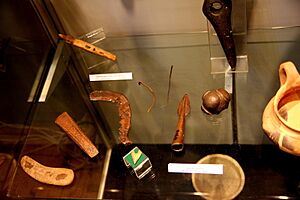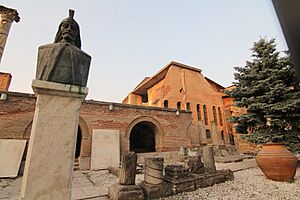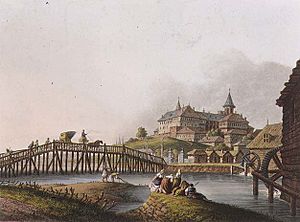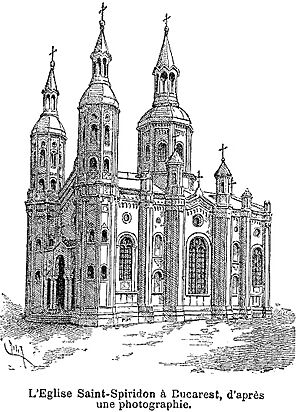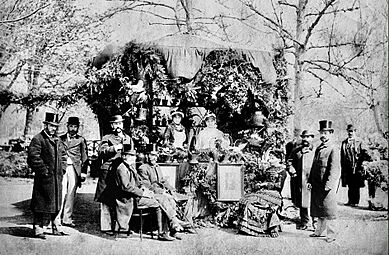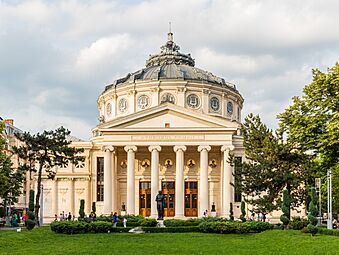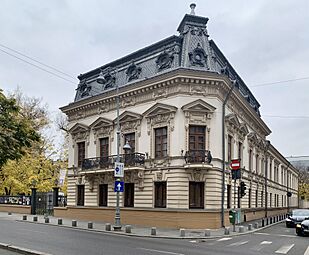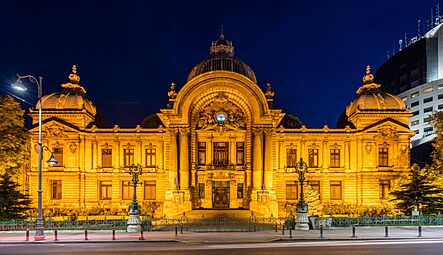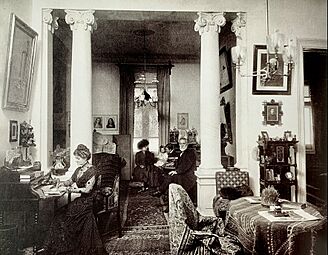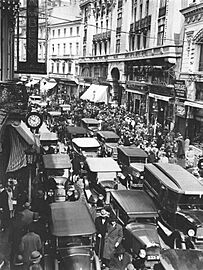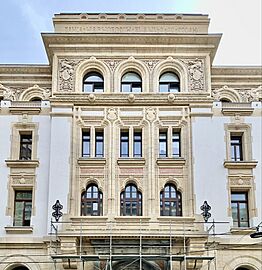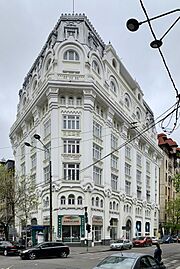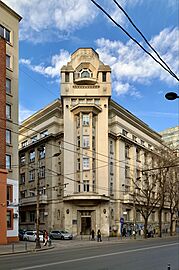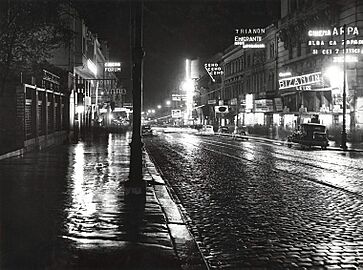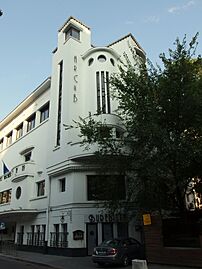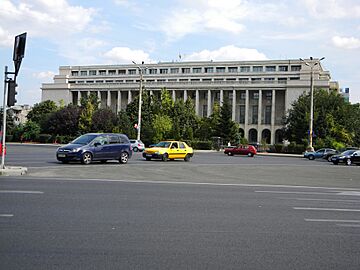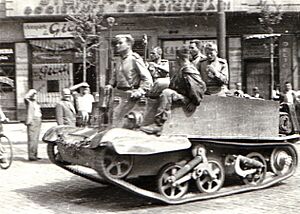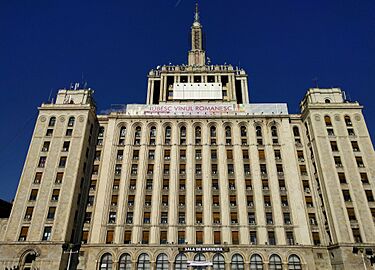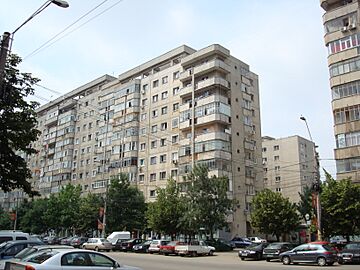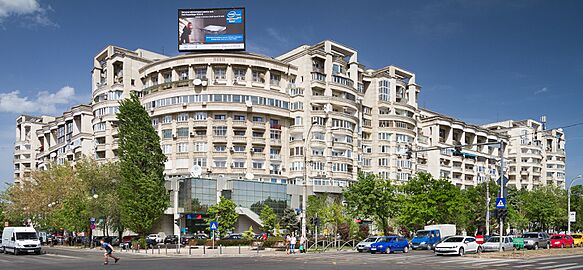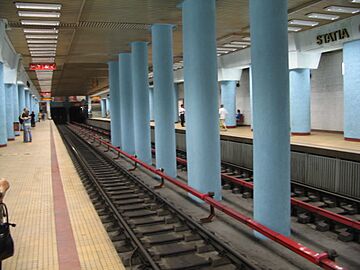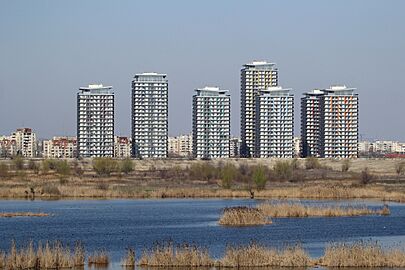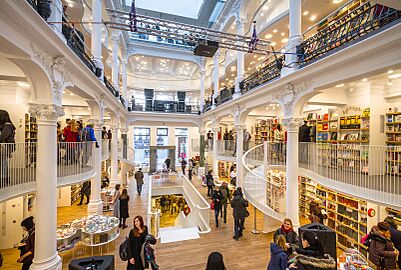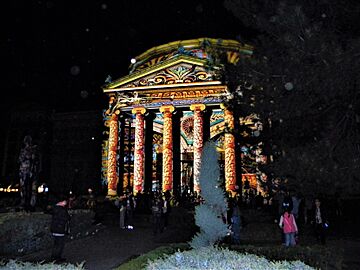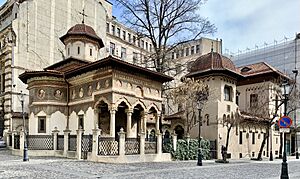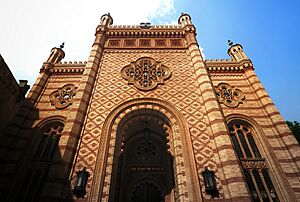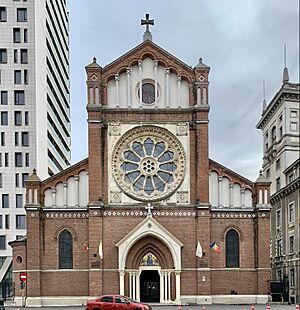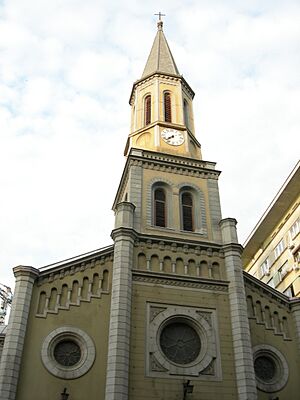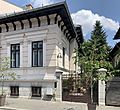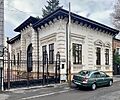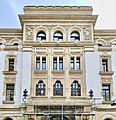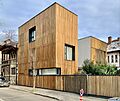History of Bucharest facts for kids
The history of Bucharest tells the story of how this famous city grew from ancient settlements into the bustling capital of Romania today. It was once the capital of Wallachia, an old Romanian land.
![]() Wallachia c. 1459–1859 (Ottoman vassal)
Wallachia c. 1459–1859 (Ottoman vassal)
![]() United Principalities 1859–1862
United Principalities 1859–1862
![]() Romanian United Principalities 1862-1866
Romanian United Principalities 1862-1866
![]() Principality of Romania 1866–1881
Principality of Romania 1866–1881
![]() Kingdom of Romania 1881-1947
Kingdom of Romania 1881-1947
![]() Socialist Republic of Romania 1947-1989
Socialist Republic of Romania 1947-1989
![]() National Salvation Front 1989-1990
National Salvation Front 1989-1990
![]() Romania 1990-present
Romania 1990-present
Contents
- Ancient Times: Early Settlements in Bucharest
- Iron Age and Roman Connections
- How Bucharest Began
- The 1600s: Growth and Challenges
- The Phanariote Era: New Rulers and Changes
- Russian Influence and Modernization (1820s-1850s)
- The 1840s and 1850s: Revolution and Change
- Capital of the United Principalities
- Capital of the Romanian Kingdom
- The Communist Era
- From 1989 to Today
- How Bucharest Was Governed
- Religious Life in Bucharest
- Bucharest's Population Over Time
- Important Treaties Signed in Bucharest
- Images for kids
Ancient Times: Early Settlements in Bucharest
People have lived in the area where Bucharest is now for a very long time. The earliest signs of human life date back to the Palaeolithic Age, which was the Old Stone Age. Tools made of flint have been found near the Colentina Lake and Fundeni Lake. Back then, this whole area was covered in thick forests.
Later, during the Neolithic period (New Stone Age), settlements started appearing. These early villages were built along the Dâmbovița and Colentina rivers. Some of the oldest Neolithic homes were found in the Dudești neighborhood. Other sites include Pantelimon and Giulești. During this time, the Gumelnița culture and Glina culture were present here. Later, in the Bronze Age, the Tei culture developed, known for its focus on raising animals.
Iron Age and Roman Connections
During the Iron Age, the land was home to people called the Getae and Dacians. They spoke an Indo-European language. Small Dacian settlements were found around Bucharest, including Herăstrău and Lacul Tei.
These ancient people traded with the Greek cities and the Romans. Ancient Greek coins were found at Lacul Tei. Roman jewels and coins were also discovered in areas like Giulești.
Bucharest itself was never under direct Roman rule for long. However, Roman coins from the 300s AD were found here. It is believed that the local people adopted Roman ways and language after the Roman troops left. This happened during a time called the Age of Migrations.
How Bucharest Began
Early Days and Legends
Slavic people also settled in the Bucharest region. Many local names like Ilfov and Snagov come from Slavic words. Some historians believe the Slavic people blended with the local population a long time ago. The area traded with the Byzantine Empire. However, it also faced invasions from groups like the Pechenegs, Cumans, and Mongols.
A popular legend says that Bucharest was founded by a shepherd named Bucur. Another story credits the legendary Wallachian prince Radu Negru. However, archaeological findings show that the area was mostly empty in the 1300s.
Bucharest's First Mentions and Growth
Bucharest was first officially mentioned on September 20, 1459. It was one of the homes of Prince Vlad III Dracula, also known as Vlad the Impaler. Soon, it became a favorite summer home for the princes of Wallachia. It was seen as a very strong city.
In 1476, the city was attacked by Stephen the Great from Moldavia. But Bucharest remained a favored residence for many rulers. Prince Mircea Ciobanul made big changes in the 1550s. He built a palace and a church in Curtea Veche (the old court area). He also added a wooden fence around the town and made sure the city had fresh water and food.
However, Bucharest also faced tough times. It was attacked by Janissary troops in 1554. Violence also occurred during conflicts between different princes in the late 1500s.
The 1600s: Growth and Challenges
Becoming a Major City
As trade with the Balkans grew, Bucharest became more important. By the end of the 1600s, it was Wallachia's largest city. Its look became more diverse, with people from many places. But this growth also came with less power for the princes and fewer state resources.
In 1594, the city saw violence when Prince Michael the Brave rebelled against the Ottoman Empire. Ottoman traders were attacked, and there were fights with Ottoman troops. In response, Bucharest was almost completely destroyed by Ottoman forces.
The city was slowly rebuilt over the next 20 years. It became a strong rival to Târgoviște as a capital. Prince Matei Basarab repaired the old court buildings in 1640.
Just 15 years later, in 1655, Bucharest was damaged again by a rebellion of soldiers. Prince Constantin Șerban added important buildings. But he also ordered a destructive fire to stop his enemies from taking over the city. A traveler named Evliya Çelebi noted that the city was rebuilt very quickly. He said houses were small but strong. Bucharest also suffered from famine and the bubonic plague in the 1660s.
A Time of Peace and Art
From the late 1650s to the early 1700s, Bucharest enjoyed a period of peace and growth. This was despite rivalries between powerful families.
The city reached its peak under Princes Șerban Cantacuzino and Constantin Brâncoveanu. During this time, Bucharest embraced a unique art style called the Brâncovenesc style. The city expanded, adding areas like Cotroceni. New inns were built, and the first schools were established, including the princely Saint Sava College in 1694. Brâncoveanu improved the old court and built new palaces. One of these was the Mogoșoaia Palace, known for its beautiful design. The famous Calea Victoriei street was also created during this period.
The Phanariote Era: New Rulers and Changes
Early Phanariote Rule
In 1716, Phanariotes began to rule Wallachia. These were Greek families from Istanbul chosen by the Ottomans. Bucharest became the undisputed capital. The city grew as trade became more important than farming. Many noble families moved to the city to work in government.
The rule of Prince Nicholas Mavrocordatos brought challenges. There was a big fire, a brief occupation by the Austrians, and another plague epidemic. However, there were also cultural achievements inspired by the Age of Enlightenment. A princely library was even created.
Princes like Grigore II Ghica and Constantine Mavrocordatos supported trade. Bucharest became a major market, especially in the Lipscani area. In 1737, the city was attacked again by Austrian troops and suffered another major plague outbreak. This led to some economic decline.
Wars and Development in the Late 1700s
Bucharest was occupied twice by Imperial Russian troops during the War of 1768–74. The peace treaty that ended this war was partly negotiated in Bucharest.
Under Prince Alexander Ypsilantis, major projects were started to bring fresh water to the city. A new princely residence, Curtea Nouă, was built in 1776. Despite more epidemics and very high taxes, the city's population continued to grow. A major earthquake hit in 1802, followed by others.
During the Russo-Turkish War of 1806–12, Russian troops entered Bucharest. This was when Manuc's Inn was built by Emanuel Mârzaian.
After the war, Prince John Caradja's rule brought important cultural and social changes. There was a new law called Caragea law. The first hot air balloon ride in the country happened here. The first theater play and the first private printing press also appeared. However, a terrible plague, known as Caragea's plague, killed many people in 1813–1814. The city at this time had a mix of crowded areas and large private gardens.
Russian Influence and Modernization (1820s-1850s)
The Greek War of Independence and a local uprising in Wallachia brought the city under the brief rule of Tudor Vladimirescu in 1821. Then, Ottoman forces took over, leading to a massacre.
After this, Prince Grigore IV Ghica ruled. He built a new palace and improved bridges over the Dâmbovița River. However, he also imposed high taxes.
In 1828, Russian troops occupied Bucharest during the Russo-Turkish War. After the war, the region was placed under Russian military rule.
A very important period began under Pavel Kiselyov (1829–1843). He gave Wallachia its first document like a constitution, called the Regulamentul Organic. Kiselyov cared a lot about Bucharest. He fought against plague and cholera epidemics. He also started a "city beautifying commission." Many central streets were paved with cobblestone, and public fountains were built. He defined the city's borders and created major roads like Șoseaua Kiseleff. He also improved the fire fighting service.
Under Prince Alexandru II Ghica, the city saw an economic rebirth. He expanded the number of paved streets and built a new Princely Palace. This was also when the first opposition to Russian rule appeared.
The 1840s and 1850s: Revolution and Change
Prince Gheorghe Bibescu continued to improve the city. He built a water supply network and public gardens. He also started building the National Theater of Romania in 1846. On March 23, 1847, a huge fire, known as the Great Fire of Bucharest, destroyed about a third of the city's buildings.
In June 1848, Bucharest was at the center of the 1848 Wallachian revolution. People wanted reforms and a more liberal government. Prince Bibescu had to give up his throne. A Provisional Government was formed, supported by large public gatherings. They passed new laws that angered the Russian Tsar.
The Ottoman Sultan, who was sympathetic to the revolt, sent an observer. Revolutionary crowds destroyed lists of old noble privileges. This led the Ottoman troops to enter Bucharest. They met resistance from a group of firemen on Dealul Spirii.
Bucharest remained under foreign occupation for several years. It was held by Russian troops during the Crimean War (1853–1854). Then, it was managed by an Austrian administration until 1856. These foreign rules brought some improvements, like the Bellu cemetery and the Cișmigiu gardens. They also introduced the telegraph and oil lamp lighting.
Capital of the United Principalities
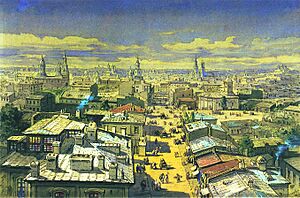
The 1856 Treaty of Paris led to the creation of special councils in Moldavia and Wallachia. These councils aimed to unite the two countries. In Bucharest, people strongly supported the union. On January 24, 1859, after public pressure, the delegates voted for Alexandru Ioan Cuza as Prince of both Moldavia and Wallachia. This led to the creation of the United Principalities of Wallachia and Moldavia. Bucharest became its capital and the seat of its Parliament.
Prince Cuza improved Bucharest's streets. He established schools and academic societies, including the University of Bucharest. He also ordered the building of a railway between Bucharest and the Danube port of Giurgiu. During his rule, brick and stone houses became common.
On February 22, 1866, a coup against Prince Cuza took place in the city. He was arrested, and a new Regency was put in place.
The people of Bucharest, who admired France, almost caused the fall of Carol I, Cuza's successor. This happened during the Franco-Prussian War after a clash with German residents. The situation was calmed by appointing a Conservative Prime Minister. When the Russo-Turkish War of 1877–1878 began, Bucharesters welcomed Russian intervention. This led the Ottomans to bomb the Danube riverbank. Romania's independence was then declared by Parliament.
Capital of the Romanian Kingdom
The Belle Époque (1877–1916)
-
Kiosk in the Cișmigiu Park. Between years 1880s and 1900s, the societies of women and not only had the habit of erecting kiosks in the Cișmigiu Park, where raffles and exhibitions were organised
-
Postal card of the Lipscani Street around 1900, with the National Bank of Romania on the right side
After Romania became a kingdom in 1881, building in Bucharest sped up. The city got gas lighting, new train stations like Gara de Nord (1872), and a horsecar tram system. The National Bank of Romania opened in 1880.
In 1883, the frequent floods of the Dâmbovița river were stopped by creating a channel for it. New buildings like the Romanian Athenaeum were added. The city's buildings also grew taller, with the Athénée Palace being one of the first to use reinforced concrete. Bucharest's trade and industry grew rapidly. Over 760 new businesses were started before 1912. Limited use of electricity began in 1882.
During World War I, on December 6, 1916, Bucharest was occupied by the Central Powers. The government moved to Iași. After the war ended, German troops left Bucharest, and Romanian rule was restored in November 1918.
Between the World Wars (1918–1940)
-
The Low Priced Dwellings Society Building in the C.A. Rosetti Square by Virginia Andreescu Haret (1926)
Bucharest earned the nickname "Paris of the East" or "Little Paris" because of its beautiful architecture and lively culture. The city grew a lot in the 1930s, which was a very good time for Romania. The population increased by 30,000 people each year. Many new neighborhoods were added, like Băneasa and Floreasca. In 1929, the old tram system was replaced by a new one.
Under King Carol II, the city's look continued to change. Many new buildings and monuments were added, often in art deco or Neo-Romanian styles. These included the new Royal Palace, the Arcul de Triumf, and the Victoria Palace. The city also got safer water sources. The northern lakes were cleaned up, creating the beautiful parks we see today.
Bucharest During the 1940s and World War II
Bucharest saw the rise of different governments during World War II. In the spring of 1944, the city was heavily bombed by British and American planes.
On August 23, King Michael I led a coup that took Romania out of the Axis and joined the Allies. Because of this, German planes bombed Bucharest, destroying the National Theater. German soldiers also fought in the streets with the Romanian Army. On August 31, the Soviet Red Army entered Bucharest.
In February 1945, the Romanian Communist Party organized a protest that led to a Communist-backed government taking power. Later that year, pro-Monarchy rallies were stopped, marking the start of political control across the country.
The Communist Era
-
Destruction of Belle Époque and interwar city-houses in 1987 during the systematization, in order to be replaced with prefabricated apartment blocks
The Communist government was fully established in Romania in 1947. Early Communist leaders built large buildings in the Socialist realist style, like the Casa Scînteii (1956). Throughout the Communist period, Bucharest grew a lot in size and population. New districts with many tower blocks were built, such as Titan and Militari.
Under Nicolae Ceaușescu's leadership, parts of the historic city were destroyed. Old churches were torn down to make way for huge new buildings. The most famous example is the Palace of the Parliament, which replaced a large area of old buildings. This project was so big it was sometimes called "Ceaușima".
In 1977, a strong earthquake, the Vrancea earthquake, caused a lot of damage. It killed 1,500 people and destroyed many old homes and offices. On August 21, 1968, Ceaușescu gave a speech in Bucharest against the Soviet invasion of Czechoslovakia. Many people joined special defense groups in response.
The Bucharest Metro subway system opened in 1979.
From 1989 to Today
-
Minimalist house no. 4A on Strada Dimitrie Racoviță (probably late 2010s)
During the Romanian Revolution of 1989, Bucharest was the scene of major events. Between December 20 and 22, the Communist government of Ceaușescu was overthrown.
After the revolution, some people were unhappy with the new government. Students and other groups organized large protests in 1990. These protests were violently stopped by miners from Valea Jiului. Other miner protests followed, with one in September 1991 reaching Bucharest and causing the government to fall.
After the year 2000, Romania's economy grew a lot. Bucharest became more modern, and several historic areas were restored. In 1992, Bucharest got its first connection to the Internet.
In October 2015, a fire at the Colectiv nightclub killed 64 people. It was a very sad event for the city.
How Bucharest Was Governed
Bucharest had a local government as early as 1563. The city's borders were set in the 1640s. For a long time, the city's leaders, called the Jude and pârgari, managed local affairs.
In 1831, people in Bucharest were allowed to elect a local council. The first Mayor of Bucharest, Barbu Vlădoianu, was elected.
Trade groups, called bresle or isnafuri, also helped manage parts of the city from the 1600s. They were made up of people from different trades or ethnic groups. These groups were important for trade and even for recruiting soldiers for the city's small army. However, they faced strong competition from foreign traders and eventually disappeared after 1875.
Religious Life in Bucharest
Bucharest is home to the main leaders of the Romanian Orthodox Church. It also has important centers for the Roman Catholic and Armenian Apostolic Church. The city is also a significant place for other religions and churches.
During Nicolae Ceaușescu's time, many religious buildings, including old churches, were torn down. This was done to make space for new, large buildings.
Orthodox Churches
For much of Bucharest's history, neighborhoods were named after important Orthodox churches. The first major church was the Curtea Veche church, built in the 1550s.
In 1658, the Metropolitan Church (now the Patriarchal Cathedral) was built. In 1678, a printing press was set up there. It printed the first Romanian-language edition of the Bible in 1688.
Under Princes Șerban and Constantin Brâncoveanu, many new churches were built. These included the Antim Monastery and the Stavropoleos Church (1724). Many new churches were also built by trader groups.
Phanariote rulers also built important churches, like the Văcărești Monastery (1720). Between the two World Wars, 23 new Orthodox churches were added to the city.
Jewish Community
The Jewish community in Bucharest was initially mostly Sephardi. Later, Ashkenazi Jews arrived from Moldavia. Jews were first mentioned as shop owners around 1550. Despite challenges, they were a big part of the city's professional life. They made up a large percentage of the population after Romanians. Their main areas were around Unirii Square and Dudești.
During World War II, Jews faced violence and attacks. Many were killed during the Iron Guard Rebellion in January 1941. Some were sent to Transnistria, but most stayed in Bucharest. They were forced to do hard labor. After the war and due to emigration, the Jewish population greatly reduced.
Today, important Jewish places include the Bucharest Synagogue and the State Jewish Theater.
Other Communities
Bucharest has always been home to many different groups. Besides Romanians, there were large communities of Greeks, Aromanians, Serbs, and Bulgarians. There were also Arabs, Russians, and Albanians. The Roma people were enslaved until 1855.
Today, Bucharest has 18 Roman Catholic churches. These include Bărăţia (built 1741) and the Saint Joseph Cathedral (1884). Catholic groups like Italians and Poles have also lived here.
Armenians have been in Bucharest since the 1600s. They built their first church around 1638. A new church, similar to one in Echmiadzin, was built in 1911.
Most Protestants in Bucharest have been Calvinist Magyars and German Lutherans. They have a church on Strada Luterană.
Islam was first present through the Turkish community. Now, it is represented by a growing community of immigrants, mostly from the Middle East. A mosque was built in Carol Park in 1923.
Bucharest's Population Over Time
| Year | Population |
|---|---|
| 1595 | 10,000 |
| 1650 | 20,000 |
| 1789 | 30,030 property-owners; 6,000 houses |
| 1810 | 42,000 (of which 32,185 Orthodox Christians) |
| 1831 | 60,587 (property-owners; 10,000 houses) |
| 1859 | 121,734 |
| 1877 | 177,646 |
| 1900 | 282,000 |
| 1912 | 341,321 |
| 1918 | 383,000 |
| 1930 | 639,040 |
| 1941 | 992,000 |
| 1948 | 1,025,180 |
| 1956 | 1,177,661 |
| 1966 | 1,366,684 |
| 1977 | 1,807,239 |
| 1992 | 2,064,474 |
| 2000 | 2,300,000 |
| 2002 | 1,926,334 |
| 2003 | 2,082,000 |
| 2011 | 1,883,425 |
| 2016 | 2,106,144 |
Important Treaties Signed in Bucharest
| Treaty of May 28, 1812: Ended the Russo-Turkish War. |
| Treaty of March 3, 1886: Ended the Serbo-Bulgarian War. |
| Treaty of August 10, 1913: Ended the Second Balkan War. |
| Treaty of August 4, 1916: An alliance treaty between Romania and the Entente Powers in World War I. |
| Treaty of May 6, 1918: A peace treaty between Romania and the Central Powers during World War I. |
Images for kids
-
Kiosk in the Cișmigiu Park. Between years 1880s and 1900s, the societies of women and not only had the habit of erecting kiosks in the Cișmigiu Park, where raffles and exhibitions were organised
-
Postal card of the Lipscani Street around 1900, with the National Bank of Romania on the right side
-
The Low Priced Dwellings Society Building in the C.A. Rosetti Square by Virginia Andreescu Haret (1926)
-
Destruction of Belle Époque and interwar city-houses in 1987 during the systematization, in order to be replaced with prefabricated apartment blocks
-
Minimalist house no. 4A on Strada Dimitrie Racoviță (probably late 2010s)


